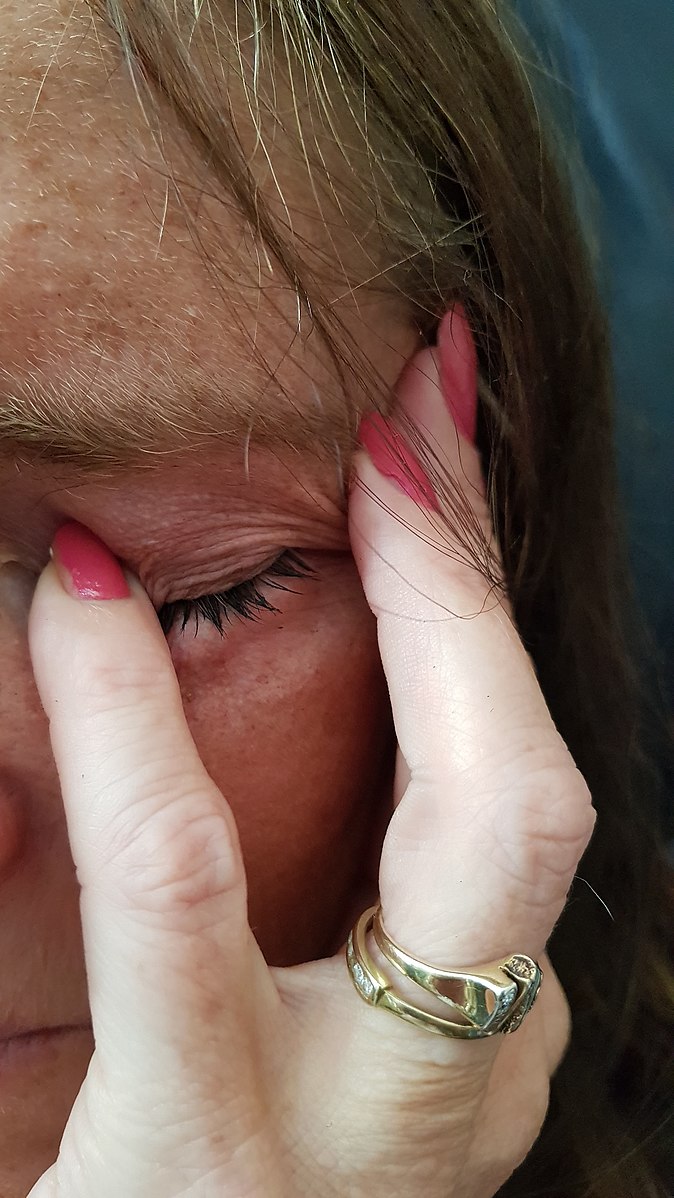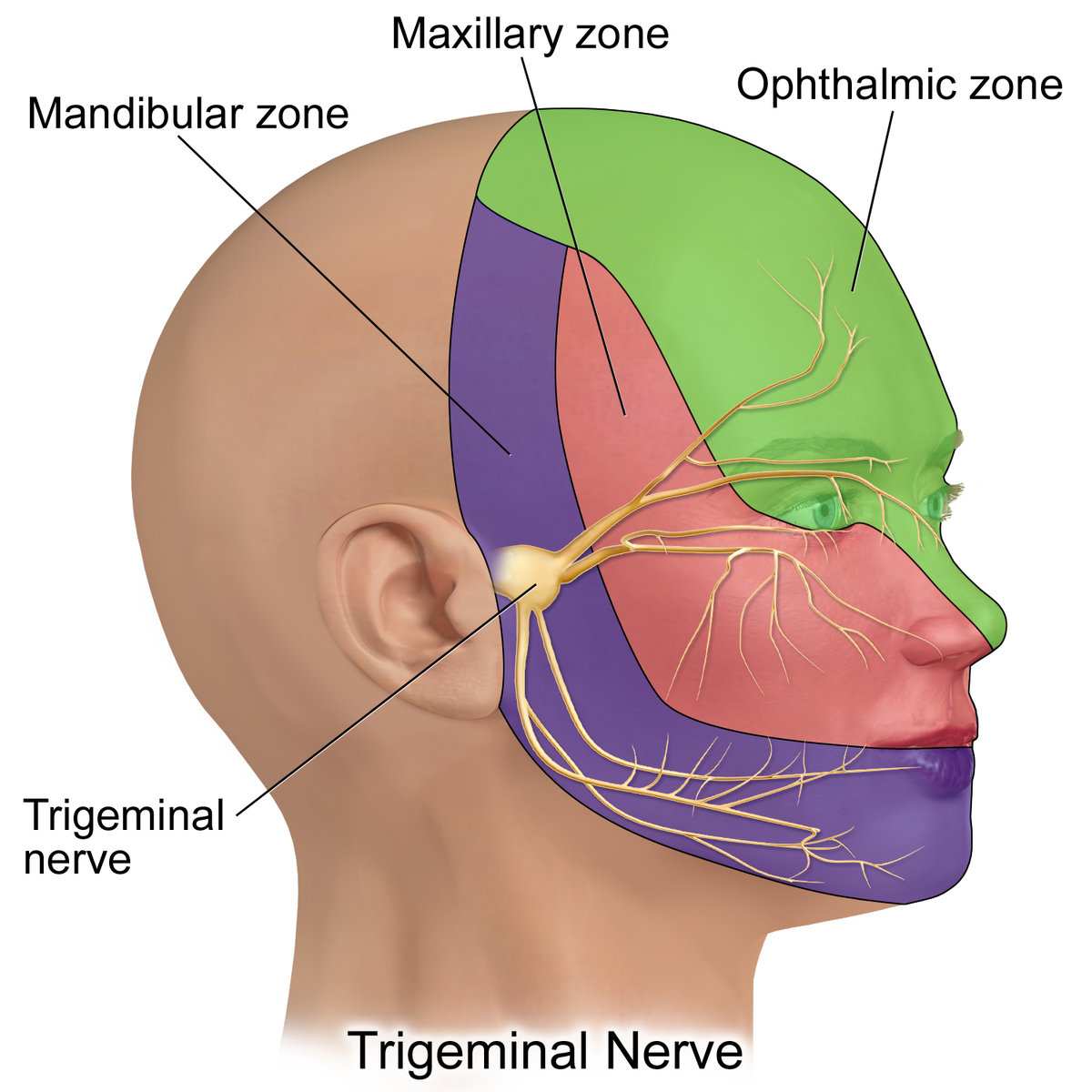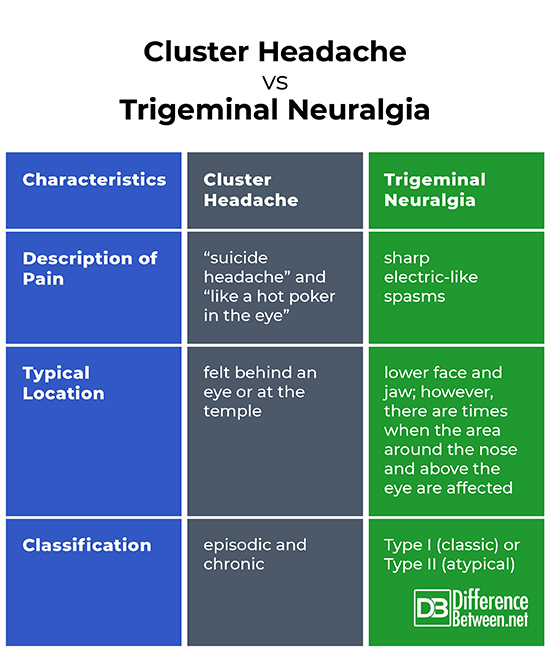Difference Between Cluster Headache and Trigeminal Neuralgia
Cluster headache and trigeminal neuralgia involve excruciating head pain on one side; they may also be experienced as chronic conditions which may affect people for weeks. Cluster headache is usually felt behind an eye or at the temple. On the other hand, trigeminal neuralgia is characterized by sharp electric-like spasms on one side of the face. The following discussions further delve into their distinctions.

What is Cluster Headache?
Cluster headache is the most common kind of trigeminal autonomic cephalalgias, a group of headache disorders. It is usually the most painful; for instance, some patients describe it as “suicide headache” and “like a hot poker in the eye”. The pain is often felt behind an eye or at the temple. It is rated as 10 out of 10 in severity and those with this condition often move or even bang their heads to distract themselves from the excruciating pain.
The main symptom is severe headaches on side; this is accompanied by other symptoms that take place on the same side which the pain is occurring. The associated symptoms include red eye, teary eye, smaller pupil, drooping eyelid, stuffy nostril, sweating of the face, and restlessness. The attacks which come in groups may recur between one to eight times per day during a cluster cycle which can last for weeks or even months. The pain may last from three minutes to three hours. The attacks often disturb people from their sleep since they tend to occur at night. The age of onset is usually between 20 and 40 years old.
Cluster headache has two classifications: episodic and chronic. Episodic cluster headache is characterized by periodic attacks which are separated by pain-free weeks, for at least a month. Chronic cluster headache occurs for more than a year with no pain-free periods or with pain-free periods which last for less than a month. The treatments include high-flow oxygen, injections (e.g. Sumatriptan and dihydroergotamine), and zolmitriptan nasal spray. Oral tablets are not recommended since they do not provide adequate relief to the attacks which intensify very quickly (American Migraine Foundation, 2019).

What is Trigeminal Neuralgia?
Trigeminal Neuralgia (TN) is characterized by sharp electric-like spasms on one side of the face. It typically involves the lower face and jaw; however, there are times when the area around the nose and above the eye are affected. This chronic condition is also often described as the most excruciating pain. It involves the trigeminal nerves (one on each side of the face) which transmit pain signals and other sensations from the face to the brain. Each trigeminal nerve has three branches which connect to the chin, midface, and forehead.
The general symptom is the sharp bouts of pain which may be caused by sound or touch. The triggers include, touching the face, eating, drinking, speaking, a breeze on the face, shaving, smiling, talking, and brushing. The spasms may last for several seconds or minutes and the attacks may last from days to months. The pain may be classified as Type I or Type II. Type I is also known as classic pain; it has definite remission periods and it is characterized as throbbing and shock-like. It is often triggered by touching one’s face or certain activities. Type II is also known as atypical pain; it may have no remission periods and is characterized as a burning and constant sensation that affects a more widespread area. Hence, Type II is usually more difficult to treat (American Association of Neurological Surgeons, 2020).
The cause is often unknown; however, some cases were found out to be due to swollen blood vessels, tumor, and multiple sclerosis. There are more women and individuals over 50 years old who have this condition. There is also no specific diagnostic test for TN and the treatments include medications (e.g. anti-seizure) and surgery (e.g. gamma-knife radiosurgery, microvascular decompression, and glycerol injections) (Pietrangelo, 2016).
Difference Between Cluster Headache and Trigeminal Neuralgia
Description of Pain
Cluster headache is described by some patients as “suicide headache” and “like a hot poker in the eye”. As for trigeminal neuralgia, it is characterized by sharp electric-like spasms.
Typical Location
Regarding cluster headache, the pain is often felt behind an eye or at the temple. In comparison, trigeminal neuralgia typically involves the lower face and jaw; however, there are times when the area around the nose and above the eye are affected.
Classification
Cluster headache has two classifications: episodic and chronic. Episodic cluster headache is characterized by periodic attacks which are separated by pain-free weeks, for at least a month. Chronic cluster headache occurs for more than a year with no pain-free periods or with pain-free periods which last for less than a month. On the other hand, trigeminal neuralgia pain may be classified as Type I or Type II. Type I is also known as classic pain; it has definite remission periods and it is characterized as throbbing and shock-like. It is often triggered by touching one’s face or certain activities. Type II is also known as atypical pain; it may have no remission periods and is characterized as a burning and constant sensation that affects a more widespread area.
Cluster Headache vs Trigeminal Neuralgia

Summary of Cluster Headache vs Trigeminal Neuralgia
- Cluster headache and trigeminal neuralgia both involve excruciating head pain on one side; they may also be experienced as chronic conditions which may affect people for months.
- Cluster headache is described by some patients as “suicide headache” and “like a hot poker in the eye” while trigeminal neuralgia is characterized by sharp electric-like spasms.
- Cluster headache is often felt behind an eye or at the temple while trigeminal neuralgia typically involves the lower face and jaw.
- Difference Between Hematoma and Melanoma - February 9, 2023
- Difference Between Bruising and Necrosis - February 8, 2023
- Difference Between Brain Hematoma and Brain Hemorrhage - February 8, 2023
Search DifferenceBetween.net :
Leave a Response
References :
[0]Image credit: https://commons.wikimedia.org/wiki/File:Trigeminal_Nerve.png
[1]Image credit: https://commons.wikimedia.org/wiki/File:Cluster_headache_introductory_phase_2018-08-31_17.14.41.jpg
[2]American Association of Neurological Surgeons. Trigeminal Neuralgia. 2020, https://www.aans.org/en/Patients/Neurosurgical-Conditions-and-Treatments/Trigeminal-Neuralgia
[3]American Migraine Foundation. Understanding Cluster Headache. 2019, https://americanmigrainefoundation.org/resource-library/cluster-headache-2/
[4]Pietrangelo, Ann. Trigeminal Neuralgia, Healthline, 2016. https://www.healthline.com/health/trigeminal-neuralgia
